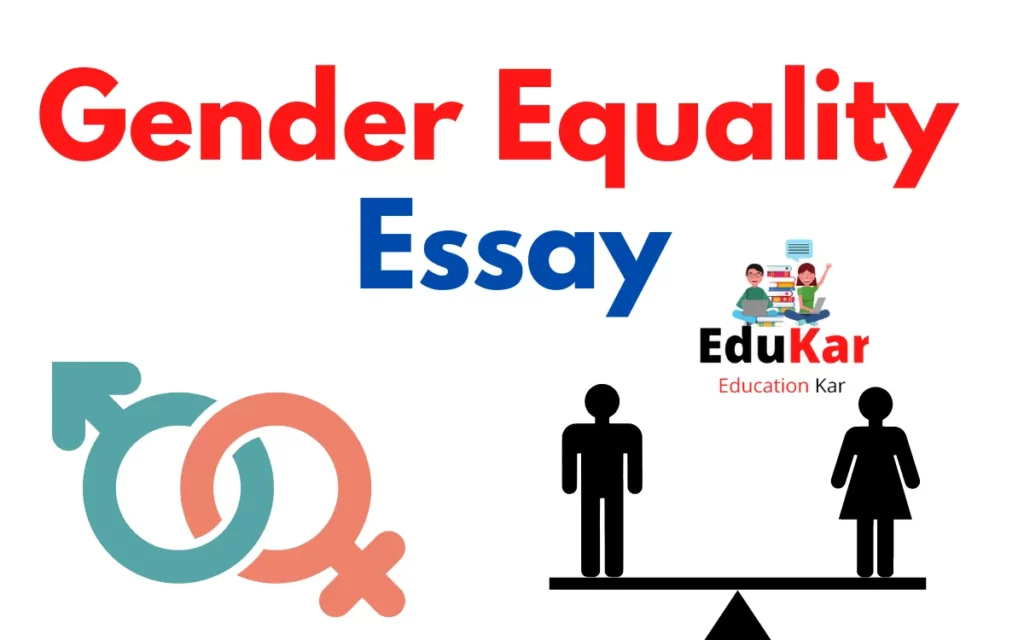Contents
Gender Equality Essay: Gender equality is a topic that has been at the forefront of many discussions and debates in recent years. It is a fundamental human right that is essential for the development and progress of any society. Gender equality is not only about equal opportunities for men and women, but it also encompasses issues related to gender identity, gender expression, and the elimination of discrimination based on gender. In this Essay, we will delve deeper into the concept of gender equality and explore the ways in which we can strive for equal rights and opportunities for all genders in our society. We will also look at some of the challenges that still exist and the actions that can be taken to overcome them. Whether you are a student writing a gender equality essay or someone who is simply interested in the topic, this gender equality essay will provide you with valuable insights and information.

Introduction
Gender equality is the belief that all individuals, regardless of their gender, should have equal rights, opportunities, and access to resources. It is a fundamental human right and essential for the achievement of a fair and just society. However, despite progress in recent years, gender inequality remains a pervasive issue worldwide. In this essay, we will explore the historical and current status of gender equality, the challenges that continue to impede progress, and solutions for achieving a more equitable society.
Historical Overview of Gender Equality
Gender equality has been a topic of discussion and debate throughout history. In ancient civilizations, women were often relegated to domestic roles and denied political and economic power. The Middle Ages saw the rise of chivalry and courtly love, which placed women on a pedestal but still denied them equal rights. The Industrial Revolution saw the entry of women into the workforce, but they were often paid less than men and faced discrimination in the workplace. In the modern era, the women’s rights movement has made significant strides in achieving legal and social equality for women, but there is still much work to be done.
Current Status of Gender Equality in India
The current status of gender equality in India is a complex and multifaceted issue. Despite the country’s constitutional guarantees of equality and the prohibition of discrimination on the basis of gender, women in India continue to face significant social, economic, and political challenges.
One of the major challenges facing women in India is discrimination and violence. According to a report by the National Crime Records Bureau, crimes against women in India have increased by 83% between 2007 and 2016. Domestic violence, harassment are particularly prevalent issues. Furthermore, the Indian legal system often fails to provide adequate protection for women, and the rate of conviction for crimes against women is low.
Another major challenge facing women in India is the lack of economic opportunities and financial independence. Despite laws mandating equal pay for equal work, women in India are often paid less than men for the same job. Additionally, women have less access to credit and financial services, which limits their ability to start and grow businesses. Furthermore, women are underrepresented in leadership positions in the private and public sectors.
Education is also a major area of concern in India. While girls have made significant strides in terms of access to education, they still face discrimination and barriers to success in the classroom. Additionally, there is a significant gender gap in literacy rates, with more boys than girls being able to read and write.
Challenges to Gender Equality
Societal attitudes and beliefs are one of the major challenges to achieving gender equality. Many people still hold the belief that men and women have inherently different roles and abilities, which leads to discrimination and bias. Economic factors also play a role, as women are often paid less than men and have less access to economic resources. Legal barriers, such as restrictive abortion laws and discriminatory family laws, also impede progress. Additionally, media representation of women often reinforces negative stereotypes and fails to promote positive role models.
Solutions for Achieving Gender Equality
Education and awareness are key to achieving gender equality. By educating people about the issue and the impact of gender inequality, we can change attitudes and beliefs. Legal and policy changes, such as equal pay laws and family-friendly policies, can also help to level the playing field. Corporate and organizational initiatives, such as diversity and inclusion programs, can also help to promote gender equality in the workplace. Finally, individual action is crucial. By challenging discrimination and bias when we see it and supporting women in our personal and professional lives, we can help to create a more equitable society.
Conclusion
Gender equality is a fundamental human right and an essential component of a fair and just society. However, despite progress in recent years, gender inequality remains a pervasive issue worldwide. By understanding the historical and current status of gender equality, the challenges that continue to impede progress, and solutions for achieving a more equitable society, we can work to create a world in which all individuals have equal rights, opportunities, and access to resources. Together, we can create a more equitable and just society for all.
FAQs for “Gender Equality Essay”
What is gender equality?
Gender equality refers to the belief that all individuals, regardless of their gender, should have equal rights, opportunities, and access to resources. It is the idea that men and women should be treated as equals in all aspects of life.
Why is gender equality important?
Gender equality is important because it is a fundamental human right and essential for the achievement of a fair and just society. Without gender equality, individuals are denied the opportunity to reach their full potential and society as a whole is hindered.
How does gender inequality affect women?
Gender inequality affects women in a number of ways. It can lead to discrimination and violence, limit economic opportunities and financial independence, and impede access to education and healthcare.
What are some challenges to achieving gender equality?
Some challenges to achieving gender equality include societal attitudes and beliefs, economic factors, legal barriers, and media representation.
What can be done to achieve gender equality?
Achieving gender equality requires a multifaceted approach, including education and awareness, legal and policy changes, corporate and organizational initiatives, and individual action. It also requires the participation of all members of society, including men and boys, to challenge discrimination and bias and support women in their personal and professional lives.
How can an individual contribute to gender equality?
An individual can contribute to gender equality by challenging discrimination and bias when they see it, supporting women in their personal and professional lives, and advocating for gender equality in their community and workplace. Additionally, educating oneself on the issue and staying informed about the latest developments in gender equality is also a significant way to contribute.

![Women Empowerment Essay [Short & Long-2023] Women Empowerment Essay](https://edukar.org/wp-content/uploads/2022/12/Women-Empowerment-Essay-1024x640.webp)







![Essay on Cricket for Students [ 250, 500 & 100 words] Essay on Cricket](https://edukar.org/wp-content/uploads/2023/01/Essay-on-Cricket-for-Students-1024x640.webp)


![Water is Life Essay in English [Class 4th, 5th, 6th,7th, 8th, 9th, 10th] Water is Life Essay](https://edukar.org/wp-content/uploads/2023/02/Water-is-Life-Essay-1024x640.webp)


